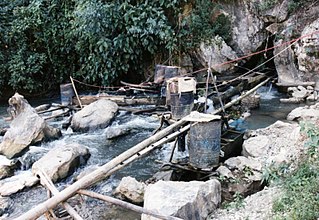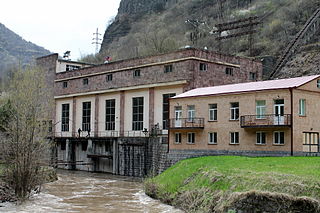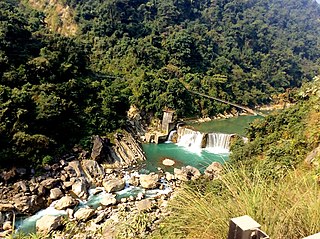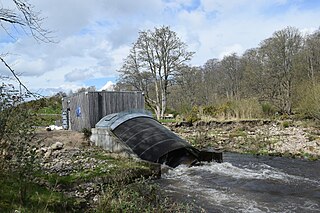
Hydropower, also known as water power, is the use of falling or fast-running water to produce electricity or to power machines. This is achieved by converting the gravitational potential or kinetic energy of a water source to produce power. Hydropower is a method of sustainable energy production. Hydropower is now used principally for hydroelectric power generation, and is also applied as one half of an energy storage system known as pumped-storage hydroelectricity.

A water turbine is a rotary machine that converts kinetic energy and potential energy of water into mechanical work.

The Archimedes' screw, also known as the Archimedean screw, hydrodynamic screw, water screw or Egyptian screw, is one of the earliest hydraulic machines. Using Archimedes screws as water pumps dates back many centuries. As a machine used for lifting water from a low-lying body of water into irrigation ditches, water is lifted by turning a screw-shaped surface inside a pipe. In the modern world, Archimedes screw pumps are widely used in wastewater treatment plants and for dewatering low-lying regions. Run in reverse, Archimedes screw turbines act as a new form of small hydroelectric powerplant that can be applied even in low head sites. Such generators operate in a wide range of flows and heads, including low heads and moderate flow rates that is not ideal for traditional turbines and not occupied by high performance technologies. The Archimedes screw is a reversible hydraulic machine, and there are several examples of Archimedes screw installations where the screw can operate at different times as either pump or generator, depending on needs for power and watercourse flow.

Small hydro is the development of hydroelectric power on a scale suitable for local community and industry, or to contribute to distributed generation in a regional electricity grid. Exact definitions vary, but a "small hydro" project is less than 50 megawatts (MW), and can be further subdivide by scale into "mini" (<1MW), "micro" (<100 kW), "pico" (<10 kW). In contrast many hydroelectric projects are of enormous size, such as the generating plant at the Three Gorges Dam at 22,500 megawatts or the vast multiple projects of the Tennessee Valley Authority.

Hydroelectricity, or hydroelectric power, is electricity generated from hydropower. Hydropower supplies one sixth of the world's electricity, almost 4,500 TWh in 2020, which is more than all other renewable sources combined and also more than nuclear power. Hydropower can provide large amounts of low-carbon electricity on demand, making it a key element for creating secure and clean electricity supply systems. A hydroelectric power station that has a dam and reservoir is a flexible source, since the amount of electricity produced can be increased or decreased in seconds or minutes in response to varying electricity demand. Once a hydroelectric complex is constructed, it produces no direct waste, and almost always emits considerably less greenhouse gas than fossil fuel-powered energy plants. However, when constructed in lowland rainforest areas, where part of the forest is inundated, substantial amounts of greenhouse gases may be emitted.

Micro hydro is a type of hydroelectric power that typically produces from 5 kW to 100 kW of electricity using the natural flow of water. Installations below 5 kW are called pico hydro. These installations can provide power to an isolated home or small community, or are sometimes connected to electric power networks, particularly where net metering is offered. There are many of these installations around the world, particularly in developing nations as they can provide an economical source of energy without the purchase of fuel. Micro hydro systems complement solar PV power systems because in many areas water flow, and thus available hydro power, is highest in the winter when solar energy is at a minimum. Micro hydro is frequently accomplished with a pelton wheel for high head, low flow water supply. The installation is often just a small dammed pool, at the top of a waterfall, with several hundred feet of pipe leading to a small generator housing. In low head sites, generally water wheels and Archimedes' screws are used.

Pico hydro is a term used for hydroelectric power generation of under 5 kW. These generators have proven to be useful in small, remote communities that require only a small amount of electricity – for example, to power one or two fluorescent light bulbs and a TV or radio in 50 or so homes. Even smaller turbines of 200–300 W may power a single home with a drop of only 1 metre (3.3 ft). Pico-hydro setups typically are run-of-stream, meaning that a reservoir of water is not created, only a small weir is common, pipes divert some of the flow, drop this down a gradient, and through the turbine before being exhausted back to the stream.
The South Somerset Hydropower Group (SSHG) is a group of 10 owners of former watermills in the South Somerset area of England who are installing micro-hydro turbines for electricity generation. The Group was founded as a result of an initiative by South Somerset District Council, and was the first of its kind in the United Kingdom. The Group won one of the 2005 Ashden Awards, and the concept has been adopted by a number of other similar groups.
Low-head hydropower refers to the development of hydroelectric power where the head is typically less than 20 metres, although precise definitions vary. Head is the vertical height measured between the hydro intake water level and the water level at the point of discharge. Using only a low head drop in a river or tidal flows to create electricity may provide a renewable energy source that will have a minimal impact on the environment. Since the generated power is a function of the head these systems are typically classed as small-scale hydropower, which have an installed capacity of less than 5MW.

Settle Hydro is a micro hydroelectric scheme, owned by the community, in Settle, North Yorkshire, England. It is located on the River Ribble, at Settle Weir near Bridge End Mill. It generates 50 kW of electricity using a screw turbine in part of the former mill race.

A tidal stream generator, often referred to as a tidal energy converter (TEC), is a machine that extracts energy from moving masses of water, in particular tides, although the term is often used in reference to machines designed to extract energy from the run of a river or tidal estuarine sites. Certain types of these machines function very much like underwater wind turbines and are thus often referred to as tidal turbines. They were first conceived in the 1970s during the oil crisis.

The Monmouth New Hydro Scheme, which incorporates the Osbaston fish pass, is a hydroelectric scheme in Osbaston, near Monmouth, in South-East Wales.
The Steffturbine is a turbine for generating electrical energy using hydropower. Their functioning and performance was proven by the scientific investigations of Ivo Baselt within the framework of his dissertation.

The Dzoraget Hydroelectric Power Station is situated in Dzoraget village, Lori Region, Armenia. The plant is located on the coast of Debed River, but it uses the flows of the waters of Dzoraget River. Construction of the Dzoraget HPP started in 1927 and it was launched on 15 November 1932 with the full installed capacity of 22.32 MW. As of 1980, the plant uses three generators with an installed capacity of 26.2 MW. The Dzoraget Hydro Power Plant is considered to be small size power plant. There is a little water storage behind the weir, as Dzoraget HPP is a run-of-the-river plant.

Ruswarp Hydro or Whitby Esk Energy, is a Hydroelectric generation scheme that operates on the River Esk at Ruswarp, North Yorkshire, England. The project uses an Archimedes Screw in a reverse direction to generate electricity and was funded by people in the community. Around 4 tonnes of water pass along the screw per second, which generates enough electricity to power 45–48 homes.

Burley Hydro Scheme, also known as Greenholme Mill Hydro is a micro hydroelectric scheme installed on the River Wharfe at Burley-in-Wharfedale, West Yorkshire, England. The power output of the hydro scheme is 330 kW with an annual output of 1,400 MWh and is the fourth hydro scheme on the river after the opening of similar power plants at Linton near Grassington, and two further downstream from Burley at Pool-in-Wharfedale and Garnett Wharfe at Otley. All of these schemes have been located on sites previously used to generate power from the water flow.

Linton Lock Hydro is a hydroelectric plant on the River Ouse in North Yorkshire, England, between the villages of Linton-on-Ouse and Nun Monkton. The first hydroelectric scheme was built here in 1923, but that was abandoned in the early 1960s. The second scheme to be sited at Linton Lock was installed in 2011 and a new generating unit came on stream in 2017. The combined output from the second and third generation plants is 380 kW, which is enough to power 450 homes.
Kirkthorpe hydro is a hydroelectric generating plant located on the River Calder at Kirkthorpe Weir, 4 miles (6.4 km) east of the City of Wakefield in West Yorkshire, England. The plant was opened in 2017 and expects to be generating electricity for 100 years. Kirkthorpe Weir is the highest industrial weir in Yorkshire and has prevented fish passing upstream to spawn; the new hydro project has a fish pass built into it.

Tinau Hydropower Plant is a run-of-river hydro-electric plant located in Rupandehi District of Nepal. The flow from Tinau River is used to generate 1.024 MW electricity.

Aberdeen Community Energy operate a micro hydro scheme at Tillydrone on the River Don, Aberdeen.





























